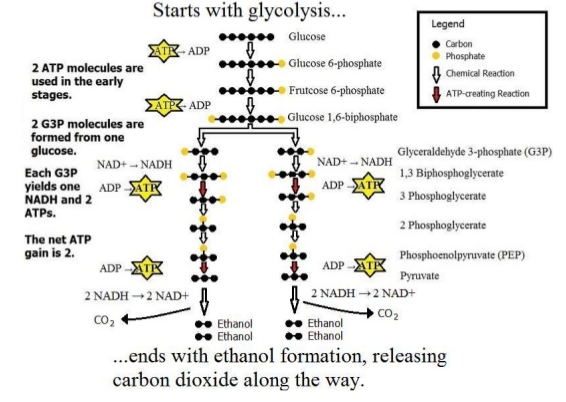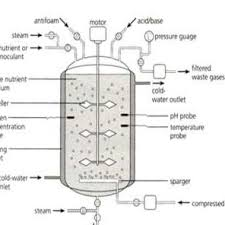Unit VII
Chemical aspect of Biotechnology
Content
The modification of living organisms according to human purposes is called as the biotechnology. The modern usage also includes genetic engineering and tissue culture technology. The application of biological organisms, systems, or processes by various industries to learning about the science of life and the improvement of the value of materials and organisms such as pharmaceuticals, crops and livestock.
The scopes in therapeutic proteins, drugs and biological organisms, such as seeds, pesticides, engineered yeasts, and modified human cells for treating genetic diseases are generated by genetic engineering. Genetic engineering is a heated topic of discussion in today’s society with the advent of gene therapy, stem cell research, cloning, and genetically-modified food. Biotechnology is the applied science and has made advances in two major areas, i.e.; molecular biology and production of industrially important bio-chemical. The scientists are now diverting themselves toward biotechnological companies; this has caused the development of many biotechnological industries.
The advances in recombinant DNA technology have occurred in parallel with the development of genetic processes and biological variations. The development of new technologies have resulted into production of large amount of biochemically-defined proteins of medical significance and created an enormous potential for pharmaceutical industries. Biotechnology in itself is a vast subject and its scope is extended to various branches of biology. This includes plant tissue culture, production of transgenic in animal and plants, applications in medicine as tools and therapeutics, creation of new enzymes and their immobilization for industrial use, development of monoclonal antibodies and control of pollutions, etc.
1) Industrial application of biotechnology: This technique is used in industries for the prevention of pollution, resource conservation, cost reduction.
2) Biotechnology in medicine: Biotechnology has a variety of applications in the field of medicine. Some of the biotechnology applications in medicine include the following:
Recombinant Insulin
Insulin is required by diabetic patients to remove excess sugar from the blood. Diabetic patients have a very low level of insulin or no insulin produced by the body. Therefore, they need external insulin to control blood glucose levels.
Later it was discovered that the insulin produced by the pancreas of the pigs can be used by humans. But there were not enough pigs to provide the quantities of insulin required. This led to the cloning of the human insulin gene.
The specific gene sequence that codes for human insulin were introduced in E.coli bacteria. The gene sequence altered the genetic composition of the E.coli cells. Within 24 hours several E.coli bacteria containing the recombinant human insulin gene were produced. The recombinant human insulin was isolated from E.coli cells.
Gene Therapy
Gene Therapy holds the most promising answer to the problem of genetic diseases. Gene therapy is used to treat genetic disorder usually by the insertion of a normal gene or correct gene for the defective or inactive gene into an individual with the help of vectors such as retrovirus, adenovirus, and herpes simplex virus.
The normal gene replaces the defective or inactive gene and carries out its functions. The therapy has the highest chances of developing a permanent cure if introduced in the earliest stages of life.
Edible Vaccines
Vaccines are obtained by animals and cell cultures. These vaccines contain inactivated pathogens.
The transgenic plants can produce antigens that can be used as edible vaccines. Antigenic proteins from several pathogens can be expressed in plants such as tomato and banana. Transgenic sugar beet can treat foot and mouth disease of animals, transgenic banana and tomato can cure diseases such as cholera and hepatitis B.
Benefits in agriculture:
Increased crop productivity
Enhanced crop protection
Improvements in food processing
Improved nutritional value
Better flavour
Fresher Produce
Benefits in Medicine:
Recombinant Insulin
Insulin is required by diabetic patients to remove excess sugar from the blood. Diabetic patients have a very low level of insulin or no insulin produced by the body. Therefore, they need external insulin to control blood glucose levels.
Later it was discovered that the insulin produced by the pancreas of the pigs can be used by humans. But there were not enough pigs to provide the quantities of insulin required. This led to the cloning of the human insulin gene.
The specific gene sequence that codes for human insulin were introduced in E.coli bacteria. The gene sequence altered the genetic composition of the E.coli cells. Within 24 hours several E.coli bacteria containing the recombinant human insulin gene were produced. The recombinant human insulin was isolated from E.coli cells.
Gene Therapy
Gene Therapy holds the most promising answer to the problem of genetic diseases. Gene therapy is used to treat genetic disorder usually by the insertion of a normal gene or correct gene for the defective or inactive gene into an individual with the help of vectors such as retrovirus, adenovirus, and herpes simplex virus.
The normal gene replaces the defective or inactive gene and carries out its functions. The therapy has the highest chances of developing a permanent cure if introduced in the earliest stages of life.
Edible Vaccines
Vaccines are obtained by animals and cell cultures. These vaccines contain inactivated pathogens.
The transgenic plants can produce antigens that can be used as edible vaccines. Antigenic proteins from several pathogens can be expressed in plants such as tomato and banana. Transgenic sugar beet can treat foot and mouth disease of animals, transgenic banana and tomato can cure diseases such as cholera and hepatitis B.
Preparation of Ethanol:

Ethanol production from molasses:

Preparation of Acetic Acid:

Enzymes help speed up chemical reactions in the human body. They bind to molecules and alter them in specific ways. They are essential for respiration, digesting food, muscle and nerve function, among thousands of other roles. Enzymes are built of proteins folded into complicated shapes; they are present throughout the body. The chemical reactions that keep us alive – our metabolism – rely on the work that enzymes carry out. Enzymes speed up chemical reactions; in some cases, enzymes can make a chemical reaction millions of times faster than it would have been without it. A substrate binds to the active site of an enzyme and is converted into products. Once the products leave the active site, the enzyme is ready to attach to a new substrate and repeat the process.
Industrial applications of enzymes:
Enzymes are used in the food, agricultural, cosmetic, and pharmaceutical industries to control and speed up reactions in order to quickly and accurately obtain a valuable final product. Enzymes are crucial to making cheese, brewing beer, baking bread, extracting fruit juice, tanning leather, and much more. The industrial uses of enzymes are also increasing since they are being used in the production of biofuels and biopolymers. The enzymes can be harvested from microbial sources or can be made synthetically. Yeast and E. Coli are commonly engineered to over express an enzyme of interest. This type of enzyme engineering is a powerful way to obtain large amounts of enzyme for bio catalysis in order to replace traditional chemical processes.
Biofuels are combustible fuels created from biomass; in other words, fuels created from recently living plant matter as opposed to ancient plant matter in hydrocarbons. The term biofuel is usually used to reference liquid fuels, such as ethanol and biodiesel that are used as replacements for transportation fuels like petroleum, diesel and jet fuel. Biofuels can also include solid fuels like wood pellets and biogas or syngas.
There are two main types of biofuels – ethanol and biodiesel. The simplest way to distinguish between the two is to remember ethanol is an alcohol and biodiesel is an oil. Ethanol is an alcohol formed by fermentation and can be used as a replacement for, or additive to, gasoline whereas biodiesel is produced by extracting naturally occurring oils from plants and seeds in a process called transesterification. Biodiesel can be combusted in diesel engines.
Biofuels are grouped by categories – first generation, second generation, and third generation – based on the type of feedstock (the input material) used to produce them.
- First generation biofuels are produced from food crops. For ethanol, feedstocks include sugar cane, corn, maize, etc. For biodiesel, feedstocks are naturally occurring vegetable oils such as soybean and canola.
- Second generation biofuels are produced from cellulosic material such as wood, grasses, and inedible parts of plants. This material is more difficult to break down through fermentation and therefore requires pre-treatment before it can be processed.
- Third generation biofuels are produced using the lipid production from algae.
A bio fertilizer is a substance which contains living micro-organisms i.e.; when applied to seeds, plant surfaces, soil, colonize the rhizosphere or the interior of the plant and promotes growth by increasing the supply or availability of primary nutrients to the host plant. Bio fertilizers add nutrients through the natural processes of nitrogen fixation, solubilising phosphorus, and stimulating plant growth through the synthesis of growth-promoting substances. The microorganisms in bio fertilizers restore the soil natural nutrient cycle and build soil organic matter. Through the use of bio fertilizers, healthy plants can be grown, while enhancing the sustainability and the health of the soil. Bio fertilizers can be expected to reduce the use of synthetic fertilizers and pesticides, but they are not yet able to replace their use. Since they play several roles, a preferred scientific term for such beneficial bacteria is plant growth promoting rhizo-bacteria.
Bio Surfactant:
Bio surfactants can be defined as the surface-active bio molecules produced by microorganisms with wide-range of applications. In recent years, due to their unique properties like specificity, low toxicity and relative ease of preparation, these surface-active bio molecules have attracted wide interest. Due to their unique functional properties, bio surfactants were used in several industries including organic chemicals, petroleum, petrochemicals, mining, metallurgy (mainly bioleaching), agrochemicals, fertilizers, foods, beverages, cosmetics, pharmaceuticals and many others. They can be used as emulsifiers as well as demulsifiers, wetting agents, foaming agents, spreading agents, functional food ingredients and detergents. The interfacial surface tension reducing ability of bio surfactants made them to play important role in oil recovery and bioremediation of heavy crude oil.
Bio reactors: A bioreactor helps to produce a large volume of culture. The bioreactor is a large vessel where the different cells such as human or plant, or animal cell are used to culture new biological products. It provides optimum conditions like temperature, pH, substrate, oxygen, etc required for the culturing of desired products. Simple stirred-tank bioreactor and sparged stirred-tank bioreactor are the two types bioreactors used for this purpose.

Reference Books:
1. Engineering Chemistry by Jain and Jain, Dhanpat Rai Publishing Co.
2. Engineering Chemistry Willey India Publisher
3. Engineering Chemistry by Marry Jane & Shultz, Cencage Learning Publisher
4. Engineering Chemistry by N. Krishnamurthy, P. Vallinaygam and D. Madhavan,
Prentice Hall of India Pvt. Ltd.
5. Engineering Chemistry by K. Sesha Maheswaramma and Mridula Chugh, Pearson India Education Pvt Ltd.
6. Engineering Chemistry by B K. Sharma, Krishna Prakashan Media (P) Ltd.
7. A textbook of Engineering Chemistry by Shashi Chawla, Dhanpatrai Publishing Co. Ltd.
8. Fundamentals of Biotechnology by B D Singh, Kalyani Publisher. New Delhi.
9. Essential of Physical Chemistry by Bahl and Tuli., S Chand & Co. Ltd, New Delhi.
10. Introduction to Nano Science by N N. Lindsay, Oxford University Press.
11. NANO: The Essentials by T Pradeep Tata McGraw-Hill Publishing Company, New Delhi.